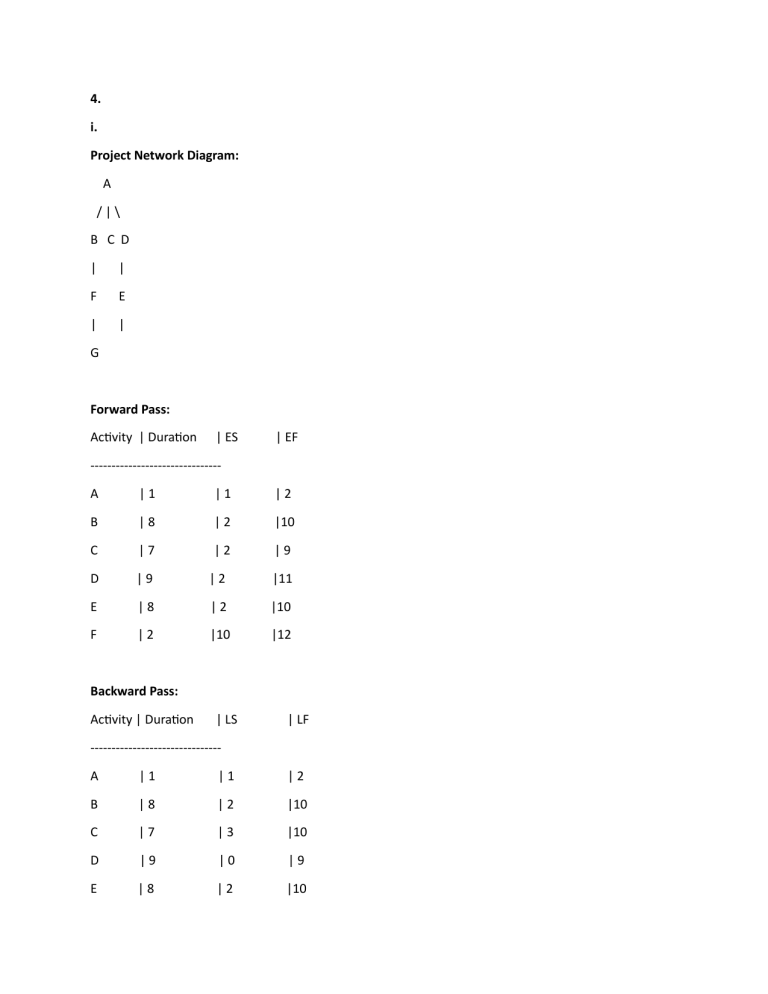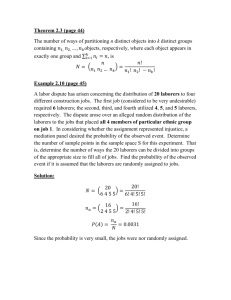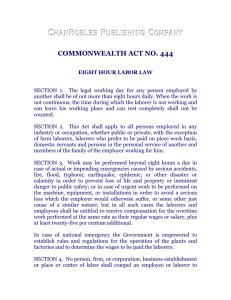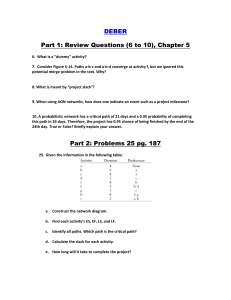
4. i. Project Network Diagram: A /|\ B C D | | F E | | G Forward Pass: Activity | Duration | ES | EF ------------------------------A |1 |1 |2 B |8 |2 |10 C |7 |2 |9 D |9 |2 |11 E |8 |2 |10 F |2 |10 |12 Backward Pass: Activity | Duration | LS | LF ------------------------------A |1 |1 |2 B |8 |2 |10 C |7 |3 |10 D |9 |0 |9 E |8 |2 |10 F |2 |10 |12 The LS of activity D is 0 because it has no successor, and the LF of activity A is the same as its EF because it has no predecessor. Based on the LF of activity F, which is 12, the project can be completed in 12 days, assuming no resource constraints. Based on the given information, activity C requires 800% laborers, which is the highest among all the activities. Therefore, the resource peak occurs during activity C, and the original project duration, just based on CPM (ignoring resource constraints), is 12 days. The CPM based project duratio is 2 dass. ii. Based on the given information, the laborer requirements for each activity are as follows: Activity A: 1 day duration with 500% laborers Activity B: 8 days duration with 400% laborers Activity C: 7 days duration with 800% laborers Activity D: 9 days duration with 500% laborers Activity E: 8 days duration with 300% laborers Activity F: 2 days duration with 100% laborers In this case, the total laborers available is assumed to be 100% (i.e., 100 laborer units). Total laborer units required = (1 x 500%) + (8 x 400%) + (7 x 800%) + (9 x 500%) + (8 x 300%) + (2 x 100%) = 5 + 32 + 56 + 45 + 24 + 2 = 164% So, the maximum number of laborer units required for this project is 164% of the total laborers available. The maximum umber of labourer u its required for this project is 264% iii. Slack Calculation: Slack for an activity = Late Start Time - Early Start Time Calculation of the slack for each activity using the CPM scheduling technique: Activity A: Early Start Time (ES) = 0 (since it has no predecessors) Late Start Time (LS) = Duration = 1 day Slack = LS - ES = 1 - 0 = 1 day Activity B: ES = EF of A = 1 day LS = 8 days (Duration of B) Slack = LS - ES = 8 - 1 = 7 days Activity C: ES = EF of A = 1 day LS = 7 days (Duration of C) Slack = LS - ES = 7 - 1 = 6 days Activity D: ES = EF of A = 1 day LS = 9 days (Duration of D) Slack = LS - ES = 9 - 1 = 8 days Activity E: ES = EF of A = 1 day LS = 8 days (Duration of E) Slack = LS - ES = 8 - 1 = 7 days Activity F: ES = EF of B (since B is a predecessor of F) = 9 days LS = 2 days (Duration of F) Slack = LS - ES = 2 - 9 = -7 days (Negative slack, indicating a critical path) Delay Activity F by 7 days to resolve the overallocation: Updated Schedule with Delayed Activity F: Activity A: 1 day duration with 500% laborers Activity B: 8 days duration with 400% laborers Activity C: 7 days duration with 800% laborers Activity D: 9 days duration with 500% laborers Activity E: 8 days duration with 300% laborers Activity F: 2 days duration with 100% laborers (Delayed by 7 days) Activity G: No information provided Recalculate of the maximum laborer units required based on the updated schedule: Total laborer units required = (1 x 500%) + (8 x 400%) + (7 x 800%) + (9 x 500%) + (8 x 300%) + (2 x 100%) = 5 + 32 + 56 + 45 + 24 + 2 = 164% So, the maximum number of laborer units required for this project after delaying Activity F by 7 days is still 164% of the total laborers available. Activits A B C D E F G ES 0 1 1 1 1 9(Delayed by 7) - The ew project duratio is 20 dass.



![Laborer Recyclable [posting]](http://s3.studylib.net/store/data/006686214_1-3308c6dd146b5b89a38fa77d3b3e6da5-300x300.png)
